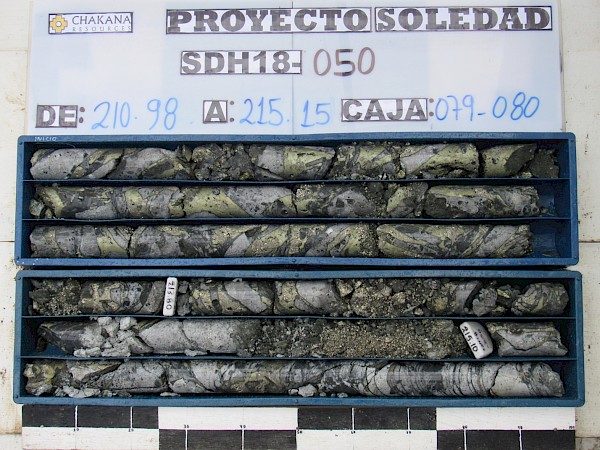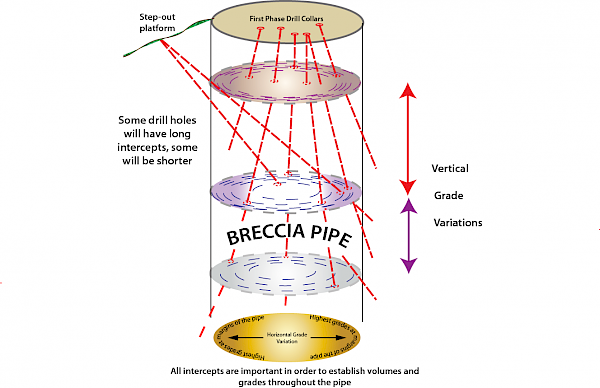Related Document
Vancouver, B.C., April 4, 2018 – Chakana Copper Corp. (TSX-V: PERU; OTC: CHKKF; FWB: 1ZX) (the “Company” or “Chakana”), is pleased to announce assays from four additional step-out holes in Breccia Pipe 1 (Bx 1) at its Soledad copper-gold-silver project in central Peru, optioned from Condor Resources Inc. The Soledad project (the “Project”) is located 35 km south of the Pierina mine in the prolific Miocene metallogenic belt of Peru. These results are a successful continuation of the drilling program that was initiated August 16, 2017, with the results of the first thirty-two drill holes released previously (see: www.chakanacopper.com). This Phase 1 drilling program is ongoing with a total of 12,328m drilled to date out of an original planned program of 16,660m and is ahead of schedule and under budget.
“These four additional holes in Bx 1 from a step-out platform drilling across the pipe demonstrate excellent continuity of the high-grade mineralization”, said President and CEO David Kelley. “Hole SDH18-049 has a very impressive high-grade margin zone with 19.4m of 2.70% Cu, 14.36 g/t Au, and 26.0 g/t Ag in a broader interval of 44.1m with 2.02% Cu, 8.50 g/t Au, and 27.1 g/t Ag. The four holes have long runs of continuous mineralization ranging from 44.1m to 73.1m. Holes SDH18-050 and SDH18-051 also intersect a deeper mineralized breccia on the southwest side of the pipe, with hole SDG18-050 having 17.85m of 3.62% Cu, 0.89 g/t Au, and 53.1 g/t Ag (Figure 1).”
New mineralized intervals from Breccia Pipe 1 are:
|
|
Az |
Dip |
From - To |
Core length (m) |
Au |
Ag |
Cu % |
Cu-eq |
Au-eq g/t* |
Note |
|
|
SDH18-049 |
220 |
-40 |
76.90 |
121.00 |
44.10 |
8.50 |
27.1 |
2.02 |
7.81 |
11.94 |
|
|
including |
|
|
77.60 |
97.00 |
19.40 |
14.36 |
26.0 |
2.70 |
12.31 |
18.83 |
Margin |
|
SDH18-050 |
218 |
-49 |
89.00 |
159.00 |
70.00 |
1.44 |
75.9 |
1.57 |
3.16 |
4.83 |
|
|
and |
|
|
198.00 |
215.85 |
17.85 |
0.89 |
53.1 |
3.62 |
4.66 |
7.12 |
Margin |
|
SDH18-051 |
215 |
-55 |
114.00 |
167.00 |
53.00 |
0.56 |
65.6 |
1.47 |
2.40 |
3.67 |
|
|
and |
|
|
227.00 |
238.00 |
11.00 |
0.48 |
12.0 |
1.01 |
1.43 |
2.18 |
|
|
SDH18-052 |
239 |
-49 |
84.00 |
157.10 |
73.10 |
1.42 |
65.1 |
1.41 |
2.89 |
4.42 |
|
* Cu_eq and Au_eq values were calculated using copper, gold, and silver. Metal prices utilized for the calculations are Cu – US$2.90/lb, Au – US$1,300/oz, and Ag – US$17/oz. No adjustments were made for recovery as the project is an early stage exploration project and metallurgical data to allow for estimation of recoveries are not yet available. The formulas utilized to calculate equivalent values are Cu_eq (%) = Cu% + (Au g/t * 0.6556) + (Ag g/t * 0.00857) and Au_eq (g/t) = Au g/t + (Cu% * 1.5296) + (Ag g/t * 0.01307).
The true widths of the mineralized intervals reported in this release are difficult to ascertain and additional drilling will be required to constrain the geometry of the mineralized zones.
Exploration Update
A total of 9 mineralized breccia pipes have been identified by mapping on the Project thus far. The pipes form a cluster within an area of four-square kilometers and are spaced between 175m to 625m apart with vertical relief between the pipes of over 500m.
The focus of the drilling program is to determine the economic potential of several of the quartz-tourmaline-sulfide breccia pipes that crop out at surface. Phase 1 is directed toward pipes 1 and 5 (Bx 1 and Bx 5). Phase 2 will be an expanded drill program proposed under a Semi-detailed Environmental Impact Assessment permit (EIA-SD) that was submitted for review to the Ministry of Energy and Mines on December 29, 2017. Phase 2 will allow for additional drill platform locations and more drill holes to test several other pipes and targets identified on the Project. Based on detailed mapping, Bx 1 has a surface diameter of 40m and Bx 5 of 50m. Mineralization is open at depth in both pipes based on previous drilling. Current drilling is designed to determine the geometry (volume) and grade of the breccia hosted mineralization. Tourmaline breccia pipes can have diameters that increase at depth, and often have higher grades at the margins of the pipe, interpreted to result from higher permeability of the breccia. Drilling at the Project is designed to test this in each pipe from surface to 400m depth based on: 1) drilling from a central platform at various azimuths and dip angles to penetrate the margin of the breccia throughout its vertical extent; and 2) from platforms outside the pipe to drill across the breccia body. The four holes from Bx 1 reported here were drilled from a step-out platform 80m northeast of the breccia pipe. Mineralized intercepts will vary in length due to the shape of the breccia body and the orientation of the drill hole (see Figure 2). For example, shallow holes drilled near the perimeter of the pipe may have shorter intercepts compared to steeper holes. Nonetheless, all holes that intersect mineralized breccia are important for constraining the overall shape and grade of the breccia body. Once a sufficient number of intercepts are obtained and modelled, the overall geometry of the breccia body and the grade profile will become apparent.
Sampling and Analytical Procedures
Chakana follows rigorous sampling and analytical protocols that meet industry standards. Samples for assay are stored in a secured area until transport in batches to the ALS facility in Callao, Lima, Peru. Samples are processed under the control of ALS with the samples including certified reference materials, a coarse and finely-crushed blank and duplicates samples. All samples are analyzed using the ME-MS41 procedure in order to obtain a comprehensive multi-element overview of the geochemistry. Gold is analyzed by ME-MS41 (considered to be least reliable), AA24 (higher precision) and GRA22 when values exceed 10 g/t. Over limit silver, copper, lead and zinc is analyzed using the OG-46 procedures.
Additional information concerning the Project is available in a technical report prepared in accordance with National Instrument 43-101 made available on Chakana’s SEDAR profile at www.sedar.com.
Qualified Person
David Kelley, an officer and a director of Chakana, and a Qualified Person as defined by NI 43-101, reviewed and approved the technical information in this news release.
ON BEHALF OF THE BOARD
(signed) “David Kelley”
David Kelley
President and CEO
For further information contact:
Michelle Borromeo, Manager – Corporate Communications
Phone: 604-715-6845
Email: mborromeo@chakanacopper.com
Neither TSX Venture Exchange nor its Regulation Services Provider (as that term is defined in the policies of the Exchange) accepts responsibility for the adequacy or accuracy of this release.
This release may contain forward-looking statements. Forward-looking statements involve known and unknown risks, uncertainties, and other factors which may cause the actual results, performance, or achievements of Chakana to be materially different from any future results, performance, or achievements expressed or implied by the forward-looking statements. Forward looking statements or information relates to, among other things, the interpretation of the nature of the mineralization at the Project, the potential to grow the Project, the potential to expand the mineralization, the planning for further exploration work, the ability to de-risk the potential exploration targets, and our belief about the unexplored parts of the Project. These forward-looking statements are based on management’s current expectations and beliefs but given the uncertainties, assumptions and risks, readers are cautioned not to place undue reliance on such forward- looking statements or information. The Company disclaims any obligation to update, or to publicly announce, any such statements, events or developments except as required by law.
Figure 1 – High grade margin zone mineralization from hole SDG18-050 in Bx 1. The five metre interval from 210.00-215.00 averages 8.15% Cu, 2.22 g/t Au, and 94.2 g/t Ag.
Figure 2 – Diagram showing relationship between drill intercepts and breccia pipe geometry with emphasis on vertical and horizontal grade variation. For the purpose of the orientation of the disclosed drill holes, the Company assumes that the breccia pipe is orientated vertically.


